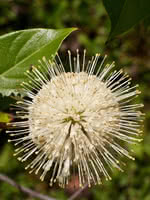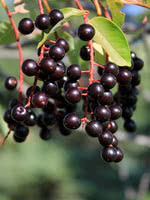Mon-Fri 9am - 5pm Mountain time
Western Chokecherry vs Buttonbush
Cephalanthus occidentalis
Prunus virginiana var. demissa
CUSTOM GROW
Buttonbush is a moisture loving shrub that provides year round interest.
It has round, fragrant flowers resembling small buttons or pincushions. The flowers transform into small reddish-brown fruit that persists into winter while the leaves take on shades of red in fall.
Providing essential food to bees, butterflies, and other insects, this shrub is versatile. Try it in your next shrub border.
Western Chokecherry is a shrub or small tree commonly used for farmstead and field windbreaks.
It produces white flowers in the spring and edible dark purple fruit that matures between September and October. Its cherries are great for making for making jams, jellies or wine, but are not very palatable for raw eating.
Buttonbush Quick Facts
Western Chokecherry Quick Facts
Toxicity: toxic to horses, cattle, etc.)

